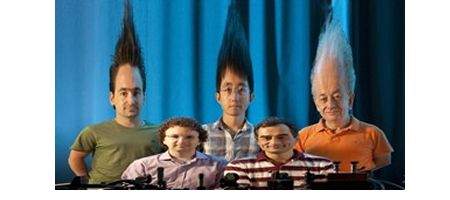Researchers at the Harvard School of Engineering and Applied Sciences (SEAS) have induced light rays to behave in a way that defies the laws of reflection and refraction, while producing some weird fun-house images on the way.

The discovery has meant a rewriting of the rule books for the centuries-old mathematical laws that predict the path of a ray of light bouncing off a surface or traveling from one medium into another.
“Using designer surfaces, we’ve created the effects of a fun-house mirror on a flat plane,” says co-principal investigator Federico Capasso.
“Our discovery carries optics into new territory and opens the door to exciting developments in photonics technology.”
The conventional laws governing the way light moves from one medium to another – from air to glass, say – predict the angles of reflection and refraction based only on the incident (incoming) angle and the properties of the two media.
But while studying the behavior of light impinging on surfaces patterned with metallic nanostructures, the researchers realized that the usual equations didn’t cover the bizarre phenomena observed in the lab.
Essentially, the group’s discovered that the boundary between two media, if specially patterned, can itself behave like a third medium.
“Ordinarily, a surface like the surface of a pond is simply a geometric boundary between two media, air and water,” explains Nanfang Yu, a research associate in Capasso’s lab.
“But now, in this special case, the boundary becomes an active interface that can bend the light by itself.”
What makes the difference is an array of tiny gold antennas etched into the surface of the silicon used in Capasso’s lab and structured on a scale much thinner than the wavelength of the light hitting it.
This means that, unlike in a conventional optical system, the engineered boundary between the air and the silicon imparts an abrupt phase shift – a phase discontinuity – to the crests of the light wave crossing it.
Each antenna in the array is a tiny resonator that can trap the light for a given amount of time before releasing it. A gradient of different types of nanoscale resonators across the surface of the silicon can effectively bend the light before it even begins to propagate through the new medium.
The resulting phenomenon breaks the old rules, creating beams of light that reflect and refract in arbitrary ways, depending on the surface pattern.
The textbooks now need to be changed, adding a new term to the equations – the gradient of phase shifts imparted at the boundary.
“By incorporating a gradient of phase discontinuities across the interface, the laws of reflection and refraction become designer laws, and a panoply of new phenomena appear,” says Zeno Gaburro, a visiting scholar in Capasso’s group.
“The reflected beam can bounce backward instead of forward. You can create negative refraction. There is a new angle of total internal reflection.”






